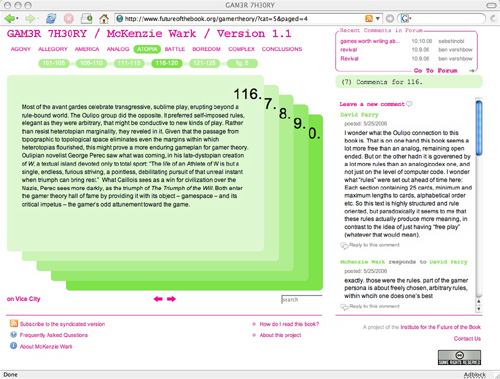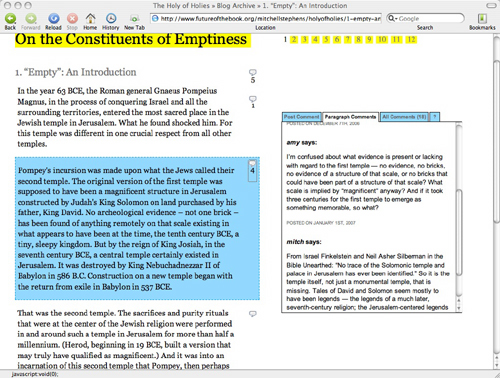I’d like to draw your attention to an exciting new project: Flight Paths, a networked novel in progress by Kate Pullinger and Chris Joseph, co-authors most recently of the lovely multimedia serial “Inanimate Alice.” The Institute is delighted to be a partner on this experiment (along with the Institute of Creative Technologies at De Montfort University and Arts Council England), which marks our first foray into fiction. A common thread with our past experiments is that this book will involve its readers in the writing process. The story begins:
“I have finished my weekly supermarket shop, stocking up on provisions for my three kids, my husband, our dog and our cat. I push the loaded trolley across the car park, battling to keep its wonky wheels on track. I pop open the boot of my car and then for some reason, I have no idea why, I look up, into the clear blue autumnal sky. And I see him. It takes me a long moment to figure out what I am looking at. He is falling from the sky. A dark mass, growing larger quickly. I let go of the trolley and am dimly aware that it is getting away from me but I can’t move, I am stuck there in the middle of the supermarket car park, watching, as he hurtles toward the earth. I have no idea how long it takes – a few seconds, an entire lifetime – but I stand there holding my breath as the city goes about its business around me until…
He crashes into the roof of my car.”
The car park of Sainsbury’s supermarket in Richmond, southwest London, lies directly beneath one of the main flight paths into Heathrow Airport. Over the last decade, on at least five separate occasions, the bodies of young men have fallen from the sky and landed on or near this car park. All these men were stowaways on flights from the Indian subcontinent who had believed that they could find a way into the cargo hold of an airplane by climbing up into the airplane wheel shaft. It is thought that none could have survived the journey, killed by either the tremendous heat generated by the airplane wheels on the runway, crushed when the landing gear retracts into the plane after take off, or frozen to death once the airplane reaches altitude.
‘Flight Paths’ seeks to explore what happens when lives collide – an airplane stowaway and the fictional suburban London housewife, quoted above. This project will tell their stories.
Through the fiction of these two lives, and the cross-connections and contradictions they represent, a larger story about the way we live today will emerge. The collision between the unknown young man, who will be both memorialised and brought back to life by the piece, and the London woman will provide the focus and force for a piece that will explore asylum, immigration, consumer culture, Islam and the West, as well as the seemingly mundane modern day reality of the supermarket car park itself. This young man’s death/plummet will become a flight, a testament to both his extreme bravery and the tragic symbolism of his chosen route to the West.
Here the authors explain the participatory element:
The initial goal of this project is to create a work of digital fiction, a ‘networked book’, created on and through the internet. The first stage of the project will include a web iteration with, at its heart, this blog, opening up the research process to the outside world, inviting discussion of the large array of issues the project touches on. As well as this, Chris Joseph and Kate Pullinger will create a series of multimedia elements that will illuminate various aspects of the story. This will allow us to invite and encourage user-generated content on this website and any associated sites; we would like to open the project up to allow other writers and artists to contribute texts – both multimedia and more traditional – as well as images, sounds, memories, ideas. At the same time, Kate Pullinger will be writing a print novel that will be a companion piece to the project overall.
We’re very curious/excited to see how this develops. Go explore the site, which is just a preliminary framework right now, and get involved. And please spread the word to other potential reader/paticipants. A chance to play a part in a new kind of story.




